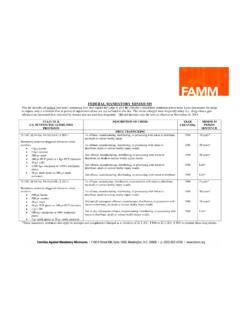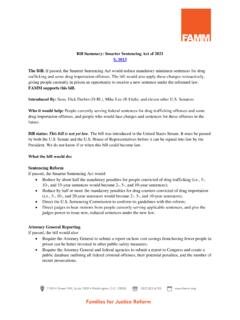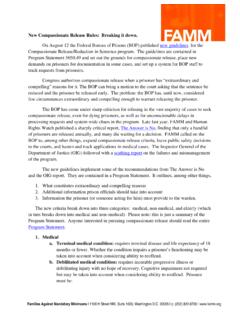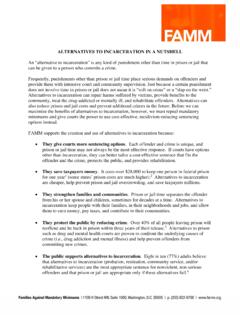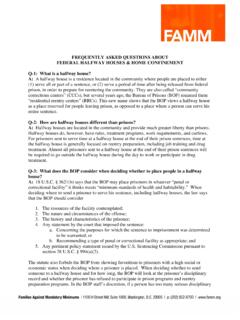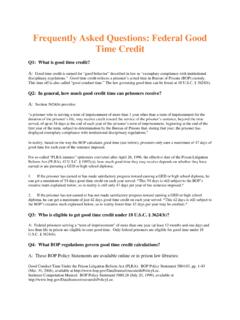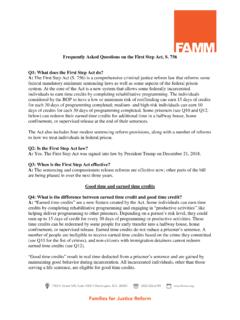Transcription of Residential Drug Abuse Program - FAMM
1 FREQUENTLY ASKED QUESTIONS ABOUT THE Residential DRUG Abuse Program (RDAP) Q1: What is the Residential Drug Abuse Program (RDAP)? A: The RDAP is a voluntary, 500-hour, nine- to twelve-month Program of individual and group therapy for federal prisoners with substance Abuse problems. It is authorized by 18 3621, which directs the Bureau of Prisons (BOP) to provide Residential substance Abuse treatment (and make arrangements for appropriate aftercare) .. for all eligible prisoners. As an incentive to get prisoners to participate, federal law allows the BOP to reduce the sentences of RDAP graduates convicted of nonviolent offenses by up to one year. Q2: Does the RDAP benefit state prisoners? A: No. The RDAP only exists in federal prisons. State prisoners cannot participate in it. Q3: Where can someone find the BOP s policy statements on the RDAP? A: On March 16, 2009, new rules issued by the BOP went into effect.
2 These new rules created some significant changes to older versions of the BOP s RDAP regulations. The 2009 rules and Program statements are available online or in prison law libraries: BOP Program Statement # (Mar. 16, 2009), available at Chapter 2 of BOP Program Statement # (Mar. 16, 2009), available at 74 Fed. Reg. 1892-99 (effective Mar. 16, 2009, codified at ). BOP Program Statement # (Mar. 16, 2009), available at Q4: What does the RDAP consist of? A: The RDAP is divided into three parts: 1) The unit-based component. This is a six- to twelve-month, 500-hour Residential Program . Participants typically live in a special section of the prison and split the day between drug Abuse treatment Program activities and prison work or educational programs. At the end of this phase, inmates receive a certificate of completion. 2) Follow-up services. Unless the prisoner is scheduled to go directly to a halfway house after finishing the unit-based component, they will be reintroduced to the general population and will participate in the follow-up services offered in the prison.
3 This is the first part of the after-care requirement. 3) Transitional drug Abuse treatment (TDAT). This lasts up to six months and occurs in a halfway house (or, sometimes, on home confinement, depending on where the BOP assigns the prisoner). This is the second and final part of the RDAP s after-care requirement. Q5: How does a prisoner complete the RDAP? A: The RDAP is only completed when a prisoner finishes all three phases. Though prisoners are awarded a certificate of completion at the end of the Residential , unit-based Program , they do not graduate until all three phases are complete. When the entire Program is completed, prisoners receive a certificate of achievement, a copy of which is placed in their central file. To complete the Program successfully, prisoners must attend and participate in all RDAP activities and pass each RDAP testing procedure. Q6: How long is the wait to get into the RDAP? A: Despite the restrictions on eligibility, the Program is very popular among those who do qualify, and space is limited.
4 The BOP has estimated that thousands of people are on the waiting list. Prisoners who get on the RDAP waiting list can be removed for bad behavior. If this happens, they must wait six months before reapplying for the RDAP. Q7: How soon can a prisoner start the RDAP? A: Ordinarily, not until they are within 24 months of their release date. Priority for entry to the Program is given to people who are closer to their release dates. Q8: Is everyone who has used or sold drugs eligible for the RDAP? A: No. Eligible prisoners are those who: Have a verifiable substance use disorder (see below); Are willing to participate in the Program ; Sign a statement accepting responsibility for the obligations of the Program ; Have at least 24 months of their sentence remaining, ordinarily; and Are able to complete all three phases of the RDAP, including the community-based Program in a halfway house. This means that anyone who is not eligible for placement in a federal halfway house is not eligible for the RDAP at all.
5 This includes: ICE (or INS) detainees (people being detained for being in the country illegally or subject to deportation after serving their sentences); Pretrial inmates (people who haven t been convicted yet); and State inmates or military inmates. If a prisoner is eligible for the RDAP, but not for the sentence reduction (see below), he can still participate in the RDAP. Q9: Can prisoners still be eligible for the RDAP if they must, for health reasons, live outside the RDAP wing or unit? A: Yes. Prisoners with physical disabilities or medical conditions that require sleeping in another part of the prison can be eligible for the RDAP. They must be otherwise eligible and able to participate in all other Program activities, including evening activities. They will be held to the same standards as all other participants and must complete the same Program requirements. Q10: How does a prisoner get into the RDAP?
6 A: Prisoners can either be referred by unit or drug treatment staff, or they can apply by making a request to the drug Abuse Program coordinator (DAPC), who will determine whether the prisoner Has enough time left on his sentence (typically, 24 months) to complete the RDAP; Has a documented and verifiable substance use disorder within the 12-month period before the prisoner s arrest for his current offense; Has a cognitive or learning impairment that makes him unable to participate in the RDAP; and Can participate in the RDAP in the language in which it is conducted (typically, English). Q11: What is a verifiable substance use disorder? A: The RDAP is limited to those who have real, verifiable substance Abuse problems and desire treatment. Verifiable means that the problem is documented, preferably in the Presentence Report (PSR). Letters from a medical doctor or mental health professional, a drug Abuse treatment provider, a parole or probation officer, a social worker, or a judge s recommendation are helpful in showing that the prisoner has a verifiable substance use disorder.
7 Two or more convictions for DUI or DWI in the five-year period before the prisoner s most recent arrest may also verify that the prisoner has a substance use disorder. Any written documentation of an inmate s substance Abuse problems should be sent to the BOP and put in the prisoner s central file. If there is no verifying documentation of a substance use disorder in the prisoner s central file, the prisoner must be given the opportunity to have documentation sent directly to the drug Abuse treatment staff at his prison. The prisoner can also have a physical examination at Health Services to document physical proof of a substance use disorder, such as track marks. Or, if a prisoner received substance detoxification when he was first admitted to the BOP, he can give the drug treatment staff permission to contact Health Services and verify that fact. Q12: What is a substance use disorder? A: It is more than merely recreational, social, or occasional use of alcohol or drugs.
8 A substance use disorder means that a prisoner s drug or alcohol Abuse meets the definition of substance Abuse or dependence in the Diagnostic and Statistical Manual of the Mental Disorders, Fourth Edition (DSM-IV): dependence includes having a history of substance use which includes the following: (1) substance Abuse (see below); (2) continuation of use despite related problems; (3) increase in tolerance (more of the drug is needed to achieve the same effect); and (4) withdrawal symptoms. Abuse is a pattern of substance use leading to significant impairment in functioning. One of the following must be present within a 12 month period: (1) recurrent use resulting in a failure to fulfill major obligations at work, school, or home; (2) recurrent use in situations which are physically hazardous ( , driving while intoxicated); (3) legal problems resulting from recurrent use; or (4) continued use despite significant social or interpersonal problems caused by the substance use.
9 The symptoms do not meet the criteria for substance dependence , as Abuse is a part of this disorder. This diagnostic impression must be reviewed and signed by a drug Abuse treatment Program coordinator. DIAGNOSTIC AND STATISTICAL MANUAL OF THE MENTAL DISORDERS (DSM-IV) (American Psychiatric Publishing, Inc. / Jaypee (4th ed. 2000). Q13: Why might someone with verifiable substance Abuse problem not be allowed to participate in the RDAP? A: The BOP may deny someone access to the RDAP by claiming that the person is in sustained remission. According to the DSM- IV, a person is in sustained remission if he has not used drugs for 12 consecutive months prior to his arrest. One exception to this rule is when the person is in a controlled environment during that 12-month period ( , closely supervised and substance-free jails, therapeutic communities, or locked hospital units. ). DSM-IV at 175-83. If a person is in a controlled environment during the 12-month period before his arrest, and does not use drugs during that 12-month period, the DSM-MD IV says the person is not in sustained remission.)
10 The 2009 BOP rules say that eligible prisoners must be able to show that they had a substance use disorder, supported by documentation, within a 12-month period before the prisoner was arrested for his current offense. See Program Statement # , Chap. 2, p. 12 (Mar. 16, 2009). This is a change to previous rules and addresses a problem that had previously been litigated in the Those facing incarceration should talk with their lawyers about how to properly document a substance use disorder so that they can participate in the RDAP in the future. Q14: What is the RDAP clinical interview? A: Every prisoner must complete a clinical interview with the drug Abuse Program coordinator (DAPC), who will decide whether the prisoner is eligible to participate in the RDAP. Prisoners are only interviewed for the RDAP after the DAPC has reviewed the documentation of their substance use disorder. The interview is usually scheduled no earlier than 24 months before the prisoner s release date.
